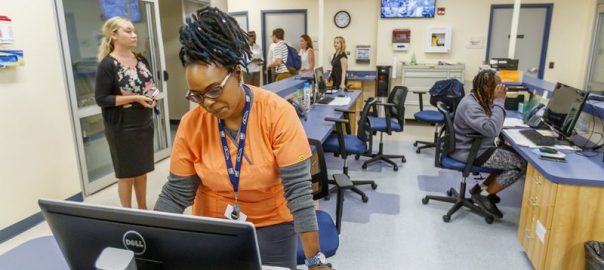Getting a person into addiction treatment often hinges on a single moment — when they feel ready to seek help.
But for people with opioid addiction, the pain of withdrawal means that moment can pass quickly, replaced by powerful urges to use again to make the misery stop. Waiting for a treatment center to open for the day may be out of the question. Detoxing in the waiting room at a crisis center or an emergency room, or trying to navigate treatment options while dealing with nausea, vomiting, craving and cramps, can squelch the strongest desire for sobriety.
That’s why city officials hope Access Point, a 24-hour treatment center that marked its official opening Wednesday, can better serve a population often deterred by red tape and long wait times.
City officials say it’s another step toward offering treatment on demand throughout the city, long a goal of Philadelphia’s behavioral health department.
For people in addiction seeking treatment, “that window of opportunity can be very narrow,” said David T. Jones, the commissioner of the city’s Behavioral Health and Intellectual disAbility Services. “If someone says they’re ready and the system trips them up, that’s a loss for them, and for the community.”
Access Point, which is run out of the Northeast Treatment Center, an addiction treatment nonprofit on Spring Garden Street in North Philadelphia, has served 306 people in opioid addiction since its “soft opening” in April. On Wednesday, it expanded to allow access to people addicted to other substances like benzodiazepines, cocaine, and alcohol.
Patients don’t need identification to enter or to be prescribed medication-assisted treatment — another common barrier to the treatment widely accepted as the gold standard for opioid addiction.
Stays in the 15-slot unit can last no more than 23 hours; the idea, said NET director Regan Kelly, is to stabilize patients enough to place them in more long-term treatments. In the unit, patients can be dosed with suboxone, a medication-assisted treatment that is an opioid; used as directed, it staves off the cravings and withdrawal pains that send people back to using, without creating euphoric effects. From there, staffers can transfer patients to inpatient or outpatient treatment, depending on what they need. And though some choose to detox without the help of medication, Kelly and Jones said they’re working to dispel the stigma that’s often attached to medication-assisted treatment — that patients are just replacing one drug with another, explaining that this is their best chance at lasting recovery.
“People continue to die in the face of evidence that medication-assisted treatment is the gold standard,” Kelly said.
So far, the unit has not had trouble locating longer-term treatment options. Jones said that of the 12,000 medication-assisted treatment slots in Philadelphia, 3,000 are still open.
“We think we’re going to fill those slots,” Kelly said.
About 113 patients who have come through Access Point opted for medication-assisted treatment, the agency said; 84 opted against it. 171 patients were referred to inpatient treatment; 43 were able to start an outpatient program, and 53 left against medical advice. (Those numbers don’t include patients who came into the center with acute psychiatric or medical issues and had to be taken to emergency rooms or crisis centers.)
Everyone who wanted treatment has been able to access it within that 23-hour window, Kelly said. Some have entered and left for treatment within four hours, she said. And about 40 Access Point patients came directly from the four heroin encampments in Kensington, two of which were cleared a month after the center opened.
Sheila Ford, NET’s community outreach coordinator, who goes to the remaining encampments twice a week trying to persuade people to seek treatment, said it is invaluable to be able to offer immediate help — even in the middle of the night.
Alone with their thoughts, outside in the quiet, she said, is often when people are most receptive to the idea.

